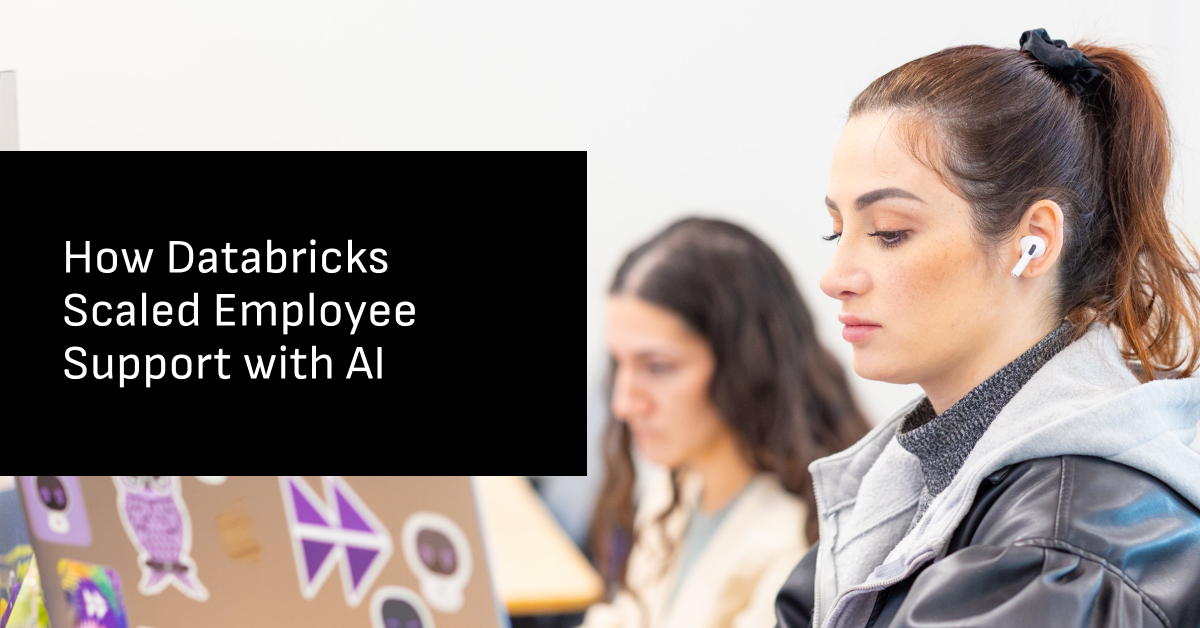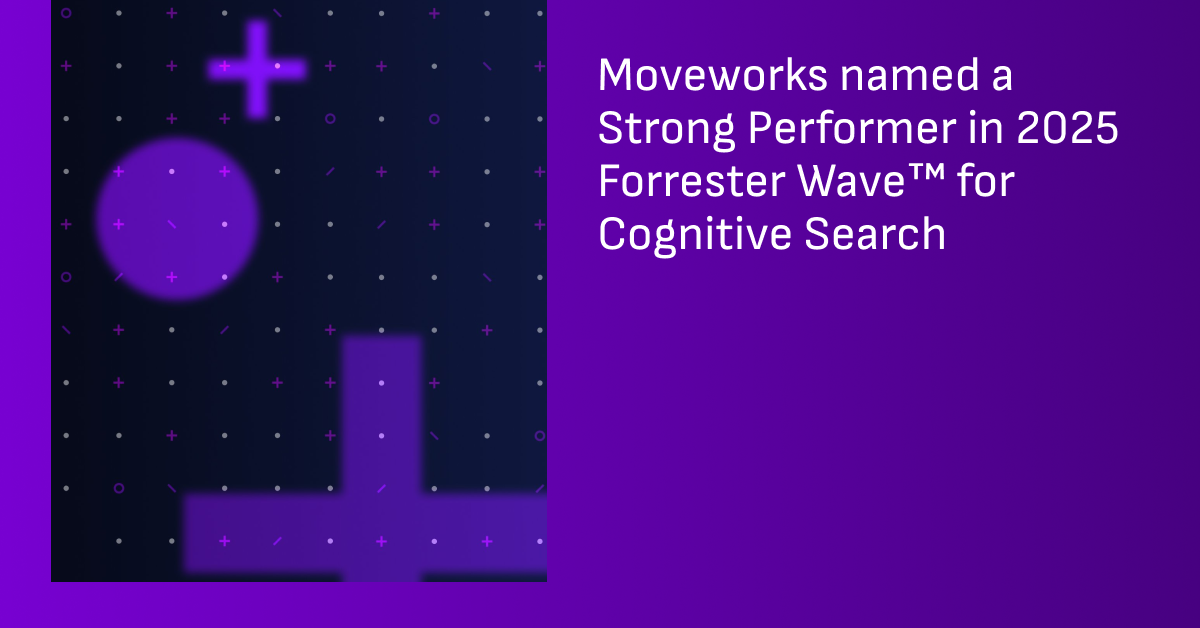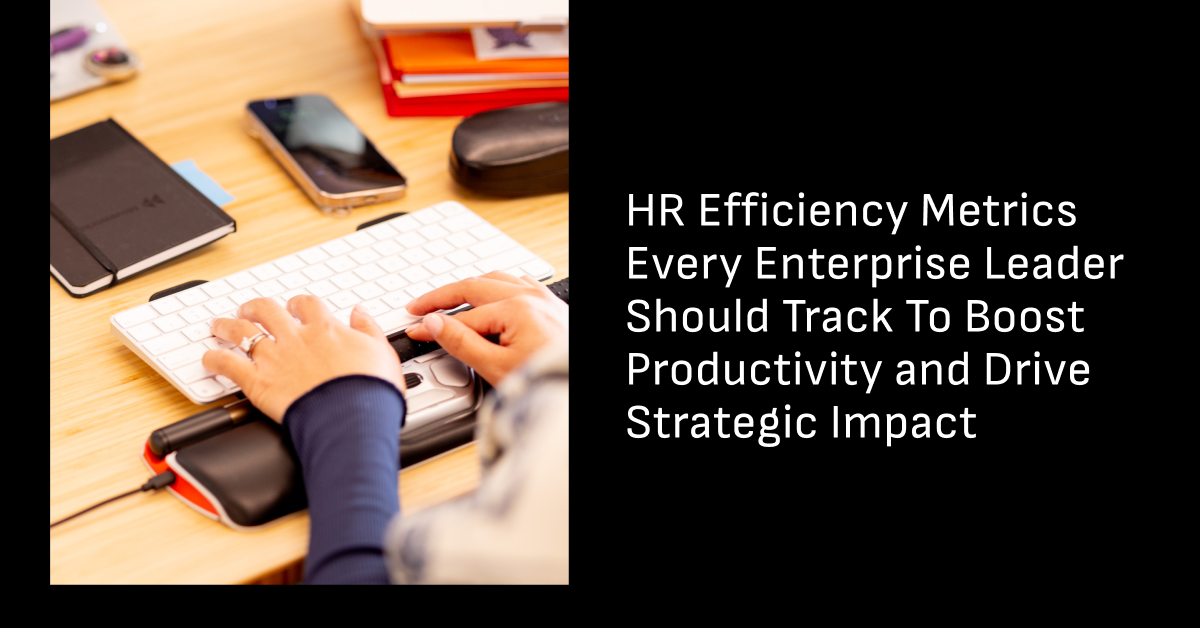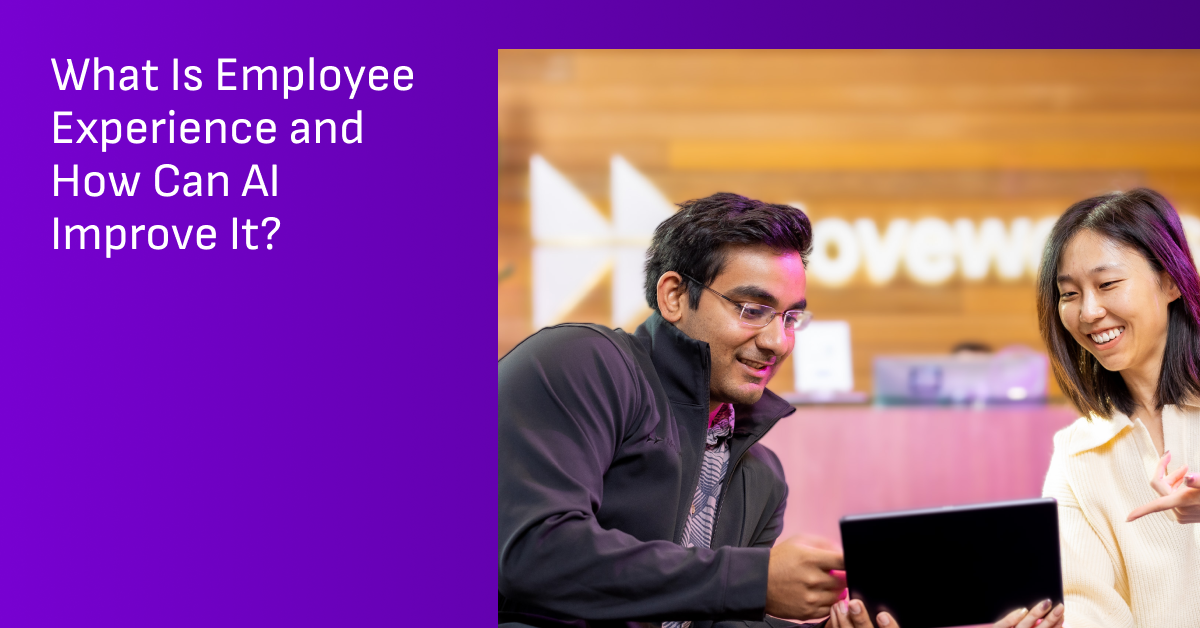Headquartered in San Francisco, California and with offices around the world, Databricks is a global leader in data and AI. Databricks is widely recognized for pioneering the lakehouse architecture — a unified approach to data analytics and AI workloads.
With over 10,000 customers, including over 60% of the Fortune 500, Databricks has experienced hypergrowth over the past few years — growing its workforce from 2,000 to over 8,000 employees in just three years.
The challenge: Scaling support without scaling cost
Databricks’ rapid growth introduced new operational challenges: the need to maintain high productivity across go-to-market teams and scale internal support functions efficiently without dramatically increasing headcount.
Databricks faced two major growing pains:
- Sales enablement at scale: With a quickly growing sales organization and rapid product innovation, training and ramping reps efficiently became a critical challenge.
- Back-office bottlenecks: With ticket volumes rising and tools proliferating from 50 to 75+, hiring more agents wasn’t scalable.
In response, Databricks embraced a philosophy of ‘extreme automation’ — or investing heavily in sales and product innovation, while automating as much of the back-office as possible. This singular approach has helped reduce General and Administrative (G&A) as a percentage of spend from double digits to high single digits over the years.
When it came to scaling sales enablement, Databricks built an internal solution to help sellers be better prepared and expedite routine sales processes like Quote to Cash, going from an almost entirely manual process to nearly 70% automation.
On back-office bottlenecks, Databricks needed a solution that could:
- Automate repetitive requests across IT, HR, and other departments
- Provide self-service capabilities to employees
- Integrate seamlessly with Slack, email, and enterprise systems
The solution: AI Assistant R2DB, powered by Moveworks
One key part of this strategy was launching R2DB — a conversational AI assistant built with Moveworks that helps employees get work done directly in Slack and email.
R2DB is named in homage to R2-D2, a nod to its ability to quickly assist across a wide range of support scenarios.
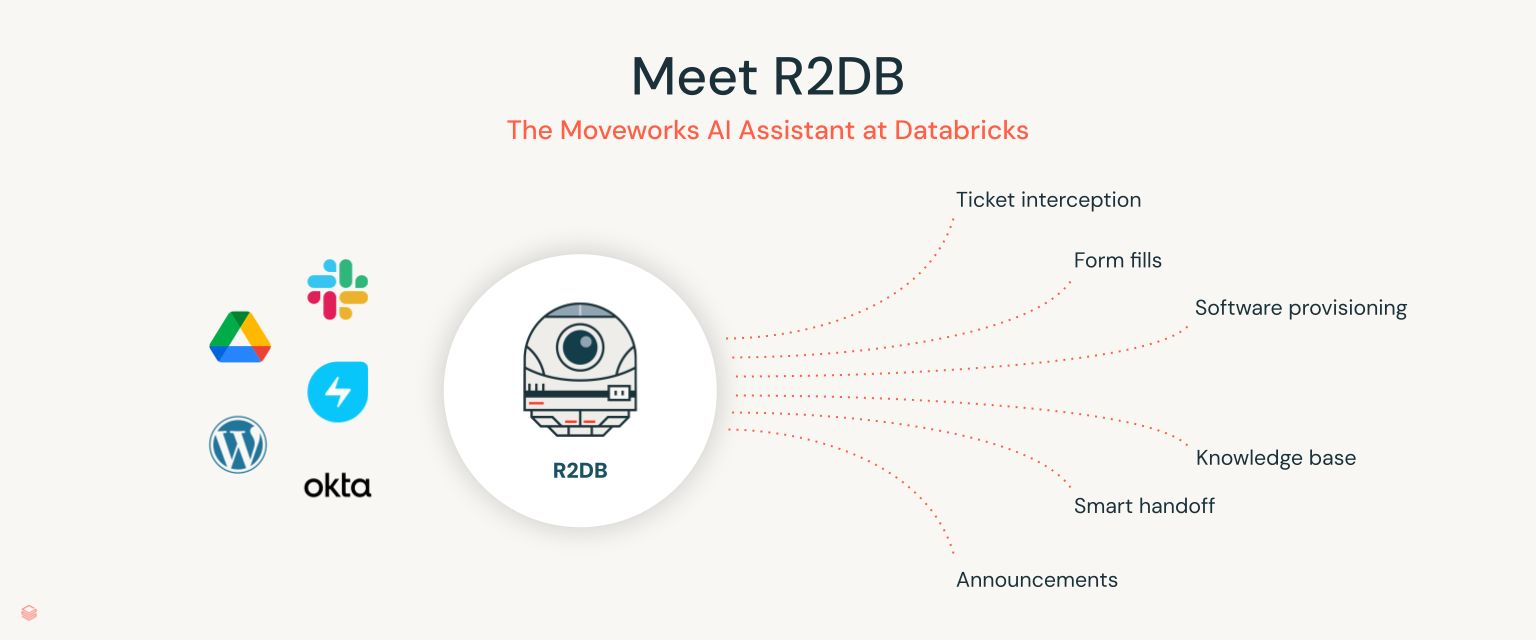
Built on an agentic AI framework, R2DB leverages Moveworks’ suite of capabilities to deliver advanced search, action, and productivity features:
- Search
Retrieves answers from internal knowledge bases (WordPress, Freshservice), HR documentation, and policy repositories — tailored to employee identity and access.
- Action
Handles tasks like software provisioning, form completion, approvals, and password resets — based on real-time context and identity management.
- Productivity
Drafts emails, translates messages, and creates articles using knowledge gaps identified in real-time conversations.
What sets R2DB apart is its multi-turn conversation engine. It retains context across complex requests, understands employee roles and entitlements, and can adapt in real time to changing input.
For instance, if an employee asks about benefits and then requests to enroll, R2DB can walk them through both — without losing the thread.
The AI Assistant is also equipped with governance-aware reasoning, helping enable all actions to comply with internal policies and access rights. It doesn’t just route users to content — it reasons through the request to provide the right answer or initiate the correct workflow automatically.
"We’ve deflected thousands of tickets and saved over a million dollars — all while delivering faster, higher-quality support. R2DB is a game changer."
— Naveen Zutshi, CIO, Databricks
Popular use cases
R2DB supports a wide range of Databricks employee needs across IT, HR, and operations. Here are some of the most common ways Databricks employees use the Assistant in their day-to-day work:
- Finding policies (e.g., "Do we have commuter benefits?")
- Provisioning software (e.g., "Grant access to Zoom")
- Filling out forms (e.g., employee verification letters)
- Managing approvals (e.g., PTO requests)
- Routing to live agents when needed
Implementation and iteration
Databricks deployed R2DB in just eight weeks — a rapid timeline that aligned with their focus on speed and agility. However, the initial rollout revealed a few rollout gaps, including low adoption and deflection impact:
- Net promoter score (NPS) was 30
- Ticket deflection was below 10%
- Low user adoption
To address this, the team undertook a number of steps, including:
- Expanded the minimum viable product (MVP) scope to include more automated workflows, ensuring that employees could resolve a wider range of issues without manual intervention
- Used R2DB as a communications channel, sharing tips, feature highlights, and updates directly in Slack to increase visibility and train employees in-context
- Improved product requirements documents (PRDs) to balance quality with speed, prioritizing high-impact use cases and ensuring new skills were clearly scoped and tested before release
This led to significant improvement:
- NPS rose to 70
- Ticket deflection climbed to 73%
- 3,500+ questions answered weekly
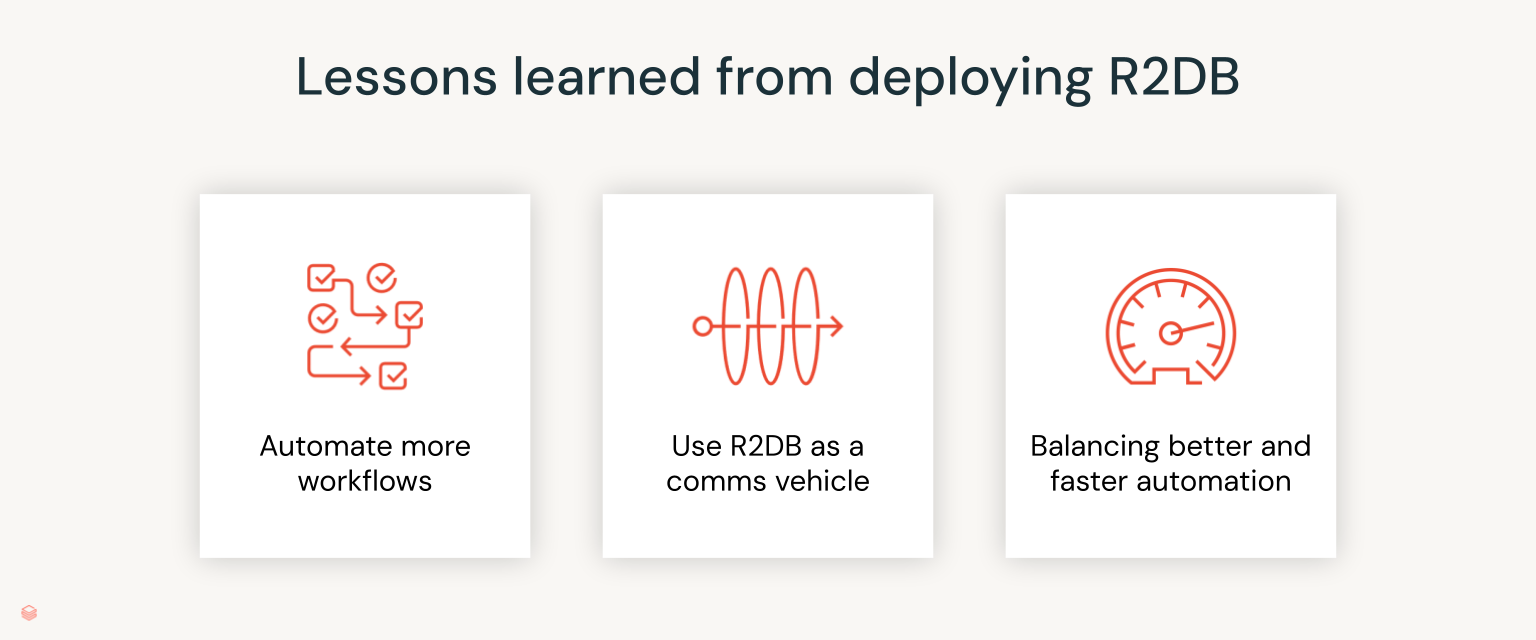
Business impact
R2DB quickly moved from pilot to enterprise scale, driving measurable impact across Databricks’ operations. Here’s how R2DB delivered tangible business impact in just one year:
- Databricks deflected tens of thousands of tickets
- Handled over 26,000 requests in a single quarter
- Realized approximately $1.5M in opportunity cost savings (equivalent to 17 agent FTEs)
- R2DB now accounts for 50% of all ticket deflections
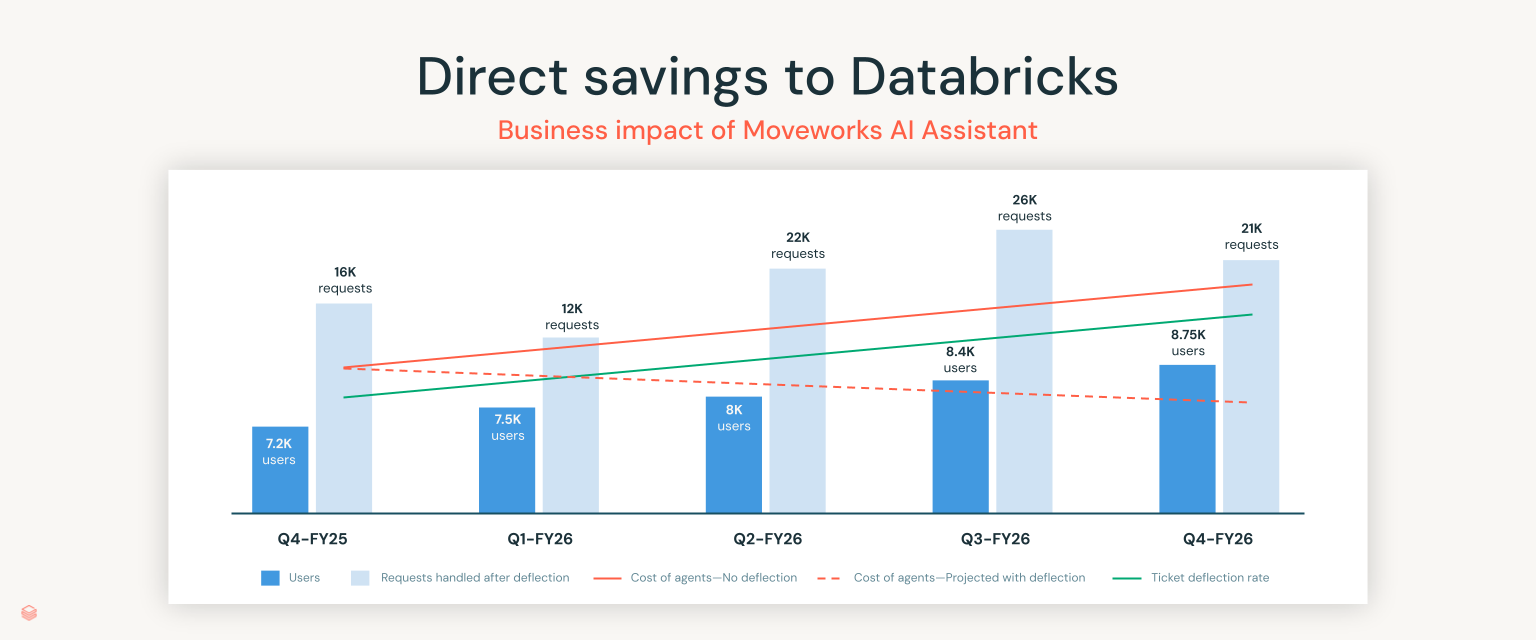
These efficiencies didn’t just show up in metrics — they also saved time across the board.
Time savings from September 2024 to March 2025
Operator hours saved | 13,800 hours |
End-user hours saved | 3,000 hours |
Total savings | $500,000 |
Key takeaways from launching R2DB at scale
Every transformation comes with its share of trial and error. Along the way, the Databricks team uncovered a few key lessons that helped them turn an early MVP into a trusted, enterprise-wide solution.
Automate more from day one
Starting with a broader MVP that included more automated workflows led to significantly higher deflection rates and faster adoption. Rather than waiting to scale, investing early in use case coverage paid off in immediate value.
Use your assistant to drive comms
Treating R2DB as a comms channel — not just a support tool—helped boost awareness and engagement. Sharing tips, updates, and new feature announcements through the assistant directly in Slack increased usage and educated employees on how to get the most out of it.
Balance speed and quality
While the team moved quickly to deploy R2DB in just eight weeks, they later saw the importance of refining PRDs and prioritizing MVP goals. This helped ensure that new workflows were not just fast to launch, but also effective in meeting user needs.
Each of these takeaways helped Databricks evolve R2DB from a reactive support tool into a proactive, high-impact part of the employee experience.
What’s next: Elevating the employee experience
Building on R2DB’s momentum, the Databricks team is working on rolling out new capabilities that deepen automation and enhance employee experience:
- Live agent handoff: Immediate Slack escalation when AI can’t resolve an issue
- Hire-to-retire workflows: Integrated onboarding, offboarding, and role changes using Workday
Databricks’ investment in an agentic AI Assistant, powered by Moveworks, has fundamentally changed how the company scales support and drives operational excellence. R2DB helps not only cut costs but also empower employees with instant access to answers and actions — enhancing productivity across the board.
Table of contents
